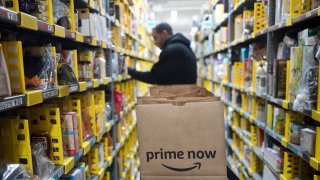
An Amazon warehouse worker at a facility in New York has tested positive for the COVID-19 coronavirus, the company confirmed to CNBC.
The employee works out of Amazon’s Queens, New York delivery station, known as DBK1. Amazon said the employee is receiving medical care and is in quarantine.
The company said it has temporarily closed the facility for additional cleaning and has sent workers home with full pay. It’s not yet clear when the facility will reopen.
"We are supporting the individual who is now in quarantine," An Amazon spokesperson said in a statement. "Since the early days of this situation, we have worked closely with local authorities to proactively respond, ensuring we continue to serve customers while taking care of our associates and we’re following all guidelines from local officials about the operations of our buildings."
News of the case was first reported by The Atlantic.
The case marks the first known incident of a worker at a U.S. Amazon warehouse testing positive for the coronavirus. On Monday, Amazon confirmed that at least five workers at Amazon warehouses in Spain and Italy contracted the disease.
As the coronavirus outbreak has worsened, Amazon said it has taken extra precautions at warehouses to protect workers.
"We have implemented proactive measures to protect employees including increased cleaning at all facilities, maintaining social distance, and adding distance between drivers and customers when making deliveries," the spokesperson said.
The spokesperson added that Amazon is regularly sanitizing all door handles, stairway handrails, elevator buttons, lockers and touch screens, among other surfaces, at its facilities.
Among the social distancing practices Amazon has implemented include suspending team meetings at the beginning of shifts, moving chairs and spreading out tables in breakrooms, halting exit screening, staggering shift start times and break times, as well as holding training in small formats. The company is also allowing employees to use phones while they’re on the job so that they can stay in contact with their family or childcare providers.
Amazon confirmed on March 3 that an employee working out of its Brazil office building in Seattle tested positive for the virus. Last week, Amazon said another employee based out of one of its offices in Seattle tested positive for COVID-19.
As the coronavirus continues to spread, Amazon logistics workers circulated a petition calling for the company to put in place more "protective measures," including giving workers paid leave.
"While Amazon has made some limited coronavirus accommodations, it needs a comprehensive plan to ensure the safety of all of its workers and the larger public, including giving workers paid leave and not simply extending our unpaid leave, as was announced recently," the petition states.
Last week, Amazon advised global employees who are able to work from home to do so through the end of March. The directive applies to employees at Amazon’s corporate offices.
Unlike employees at Amazon’s corporate offices, many fulfillment center employees and delivery drivers cannot carry out their job duties while working from home. Amazon moved to address the unique needs of fulfillment centers and delivery by launching a $25 million relief fund. The "Amazon Relief Fund" will allow these employees to apply for grants that are equal to or up to two weeks of pay if they’re diagnosed with the novel coronavirus, or COVID-19.
The company also said it will provide up to two weeks of pay to all employees diagnosed with COVID-19 or placed into quarantine, effective immediately. This is in addition to unlimited unpaid time off for all hourly employees through the month of March, which CNBC previously reported.
Additionally, Amazon has been hit with a wave of delivery delays and product shortages amid the coronavirus outbreak. The company has been working to avoid disruptions at its fulfillment centers, while some warehouse workers miss shifts. In response, Amazon announced Monday it will hire an additional 100,000 warehouse and delivery workers.
This story first appeared on CNBC.com. More from CNBC:

